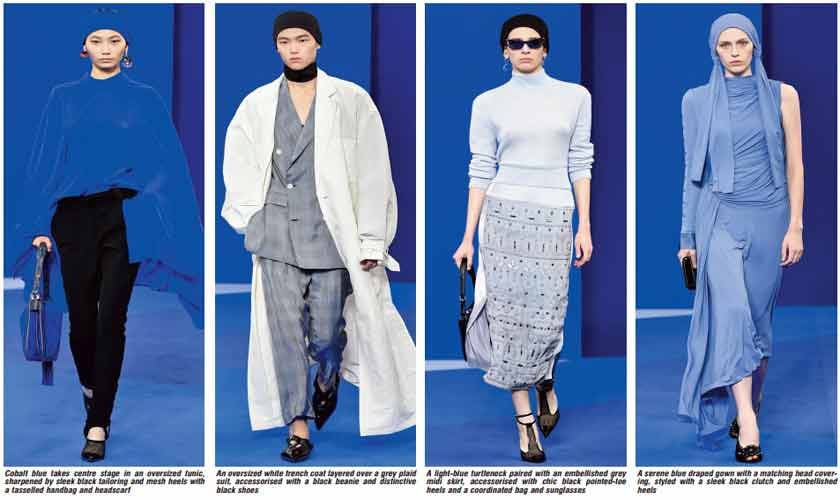Artistic director Peter Copping presented his second show for Lanvin with a clear reference to the 1920s, the decade when founder Jeanne Lanvin defined her design aesthetic and Art Deco reached its peak in Paris. The timing aligned with the centenary of Art Deco, marked in 2025. That same iconic Lanvin blue appeared on the runway and in several dresses, reinforcing the collection’s deep connection to its roots.
The collection leaned into Jazz Age style with low-waisted gowns, geometric motifs, and headbands. Copping added a sensual note by opening flapper dresses at the sides and fastening them with ribbons around the hips. Jackets featured puffed shoulders and were secured at the back with fabric ties, while trench coats were shaped like dresses with defined waists and full skirts. Particularly striking were white skirts with black inserts, inspired by Deco geometry and shaped into a sharper, more minimal form.
A highlight of the show was the robe de style, a hallmark of Jeanne Lanvin’s 1920s designs. Defined by a fitted bodice and a wide, side-flared skirt, it offered a romantic counterpoint to the straight silhouette of the flapper dress and framed the entire collection beautifully. Updated in washed silks, these gowns took on a softened, elegant look. Embroidered diamonds, ribbon details, and draped scarf prints expanded the reference points, while knit dresses suggested a subtle nod to the 1930s.
The soundtrack, “Visages Fade to Grey,” reinforced the dialogue between archival source and present interpretation, further immersing the audience in the period inspiration.
Eveningwear set the tone for the collection, designed with precision and balance. Copping explained that the starting point was the archive—not just the clothes but also Jeanne Lanvin’s fascinations. To reinterpret these influences, he layered chiffon over jewel-like embroideries and reworked archival motifs into modern prints.
On the other hand, menswear felt less consistent. The range included lime denim, technical outerwear fabrics, and oversized leather coats. This category remains exploratory and shows Lanvin’s ongoing development in menswear.
One of the show’s most notable qualities was its restraint. While many Paris fashion stages leaned on spectacle, Copping focused on clarity and refinement. Embroidered criss-cross patterns, hand-pleated skirts, and liquid silks were thoughtfully paired with coats and trousers, resulting in a collection that pointed toward durability rather than mere display.
Under Copping’s direction, Lanvin projects stability and careful research. The work is poised and deliberate, embodying a controlled elegance. The key question now is whether this polished restraint will translate into influence within today’s competitive market.
The challenge lies in moving beyond preservation to establish true authority. Copping has delivered polish and consistency grounded in archival research; the next step is to convert this quiet elegance into a commanding presence that places Lanvin firmly at the center of the fashion conversation.
Only time will tell.
https://www.thenews.com.pk/tns/detail/1348277-blue-notes-of-deco
